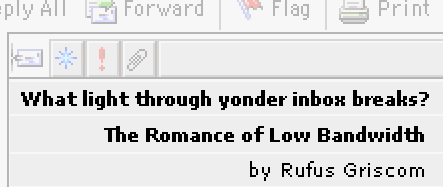
Descriptions of the future of sex and the Internet tend to feature this same cast of characters and sometimes ourselves wired for super-sentience, every last goosebump crocodile-clamped to some electro-stimulator-thingy. We'll be in a Where's Waldo of cyber-bodies, sandwiched between Elizabeth Hurley, James Dean and Betty Boop, all crescendoing with the wand-synchronized precision of the New York Philharmonic.
Perhaps. Some day. But in the meantime, a realistic look at the way the Internet has affected most people's experience of sex pulls up a much different, lower resolution picture. In these early days of the Web, photographs are relatively blurry and pornographic video resembles flickering, barely discernable "figure studies" popular at Nickelodeons a century ago. Compared with the magazines and video that preceded the Internet, online porn seems almost quaintly suggestive.
In this low bandwidth environment, the single most culturally transformative use of the medium has been e-mail, and this remains equally true in the sexual arena. No online feature has affected more sex lives more profoundly than the electronic resuscitation of the billet-doux: the love letter. Sure, tens of thousands of amateur porn sites have proliferated in recent years, but hundreds of millions of e-mails are exchanged every day, and how many of them contain a little eyelid-fluttering? Lust letters may be a better description of much of what circulates, more reminiscent of scrunched up pieces of paper arching across high school study halls than the rapturous missives of Abelard and Heloise. But it makes for charming interlocution all the same.
The e-mail is in many ways the perfect form of communication for lovers: it offers the contemplative languor of the letter with the impulsive fluster of the phone call. Its mongrel cousin, online chat, has none of the measured gravitas of the epistolary tradition it has the light, choppy cadence of conversational volleyball and yet it shares with e-mail the seductive power of simultaneous mental presence and physical absence. It's odd to consider that these space-age technologies have pushed us towards more restrained forms of communication, with all their attendant finesse, legerdemain and romance.
Of course more bandwidth is coming, and this will mean more moving pictures. The first words uttered over a telephone line were, "Watson, come here"; I fear the first uttered over a high-resolution Internet tele-video connection will be, "Watson, slowly remove your shirt." Tele-video systems exist today, of course, but they are either extremely low quality or prohibitively expensive (and inconveniently located in the conference rooms of large media companies). This will change, and so the communicative austerity of the e-mail will gradually become a choice rather than a prevailing convention.
Perhaps in the same sense tele-video will remain a choice as well; those who fear its intrusion will have the option of smacking the off button and saying, "I can't get this darned thing to work." If scent/pheromone projectors are added to the layers of online communication, they are likely to have even more "technical problems." Each additional layer of communication we choose to employ will enhance our ability to make assessments about one another: e-mail reveals thoughts; voice adds mood and personality; video exposes dress, facial symmetry, posture, eye contact and fidgeting; smell betrays nervousness, grooming and some scientists believe the genetic compatibility of immune systems. We will adjust our digital Venetian blinds to select the preferred quantity of exposure. The greater the data flow, of course, the greater the potential for trouble (in the good sense of the word). The Internet has already produced more complicated definitions of intimacy and infidelity; the shades of gray will continue to multiply.
So too will the number of prospective partners in crime. Matchmaking services, like Hooksexup Personals, already make it possible to search among hundreds of thousands of people around the world for someone who shares your obsessions with Scorsese, chicken masala and "I'd Rather Be Spanking" bumper stickers. One hundred years from now the idea of selecting a husband or wife without using online filtering systems (expecting to bump into them in your youthful wanderings) will seem like looking for a book in a library without using the card catalog system (or perhaps like using a library at all when you can order a book with a few key strokes). These relatively simple telecommunication enhancements will have more of an impact on our experience of sex more dramatic in the long run and more competent in the short run than all the Virtual Reality body suits depicted in our collective sexual fantasies.
Of course the porn market will also develop and grow with additional bandwidth, but porn is finally a placeholder, a caricatured cardboard cutout of the person (or set of triplets) we hope to meet. It seems that what we all really want is access to each other. And more than any other, this simplest human need will drive the Internet's future.
Rufus Griscom
What Are We Thinking?